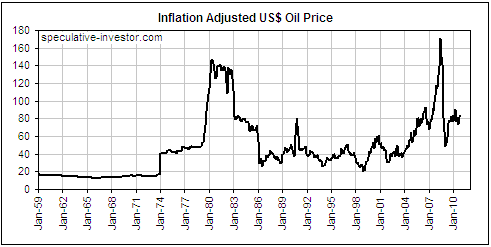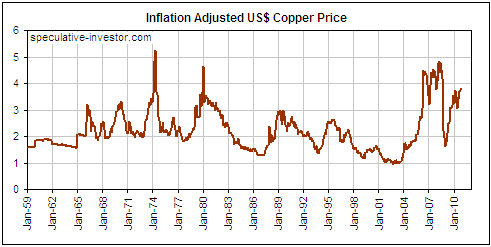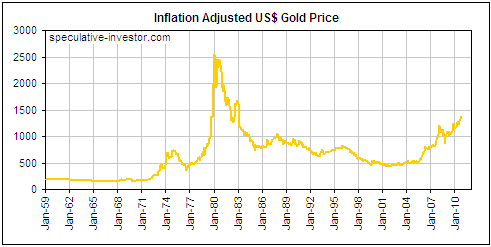 |
|
Inflation and the "Commodity Supercycle"
Our
view is, and has always been, that the rapid economic growth occurring
in countries such as China and India is NOT the primary driver of the
long-term bull market in commodities that is often referred to as the
"commodity supercycle". Instead, we see the bull market as mostly an
effect of inflation, where inflation is defined as an expansion of the
money supply. One of the consequences of inflation is a reduction in
the value of money relative to some of the things that money can buy.
We'll endeavour to support our view using some inflation-adjusted
charts, but before doing so we should explain the method we've used to
adjust for the EFFECTS of inflation. We emphasised "effects" in the
preceding sentence because what we want to adjust for is the loss of
purchasing power (PP) that eventually results from monetary inflation,
not the monetary inflation itself.
Of course, the most popular way of adjusting for the effects of
inflation is to use official price indices such as the CPI or the PPI.
However, this way of doing the adjustment is all but guaranteed to
arrive at a bogus result, and not just because the government does its
best to understate the currency's loss of PP. We would also end up with
a bogus result if we were to use the price indices calculated by Shadow Government Statistics.
The reason is that all such indices are based on a false concept, which
is that you can come up with a single number that represents the
average economy-wide price level by adding together, once per month,
the prices of a "representative sample" of the things that are traded
within the economy. The reality is that disparate items* cannot be
added together in a way that produces a sensible result. Furthermore,
it isn't possible to come up with a representative sample that will
consistently reflect what's happening to prices across the entire
economy.
Although price data cannot be used to determine a number that
consistently paints an accurate picture of the change in a currency's
PP, the situation isn't hopeless. This is because we can apply economic
theory to deduce an estimated change in PP that stands a good chance of
being roughly correct over the long term.
The theory that we will apply can be summarised as follows: The
percentage reduction in a currency's purchasing power should, over the
long-term, be roughly equal to the percentage increase in its supply
minus the percentage increase in the combination of population and
productivity. For the purpose of this exercise, we will assume that the
average annual increase in the combination of US population and
productivity has been 3% over the past 50 years (population growth has
averaged 1.1%/year over this period, so we are making the assumption
that productivity growth has averaged 1.9%/year), which amounts to an
average of 0.25%/month. Based on this assumption we can deduce a
monthly inflation adjustment by subtracting 0.25% from the
month-to-month percentage increase in TMS (True Money Supply). During
any given month or any given year the inflation adjustment estimated
using this method will likely be wrong (due mostly to the long and
variable delays from a change in money supply to the associated change
in PP), but it should be approximately correct over periods of 7 years
or more. It is therefore a big improvement over the price index
approach, which is all but guaranteed to be totally wrong over the
long-term.
We now turn to the charts mentioned in the second paragraph. These
charts show the real performances, in current US$ terms, of oil, copper
and gold since 1959, with adjustments for inflation having been made
using the method described above.
Here's what the charts tell us:
1. In real terms, the 1973-1980 and 2001-2008 rises in the oil price
were similar. The inflation-adjusted (IA) oil price exceeded its 1980
high in 2008, but not by much and not for long. As things currently
stand, the IA oil price is near its average of the past 35 years, which
contradicts the notion that the combination of "Peak Oil" and
"Chindia's" growth is behind oil's upward re-rating.


The main reason that gold has continued to make real progress since mid
2008 is that the bulk of the world's gold supply is held for
store-of-value purposes, with only a tiny fraction being consumed in
industrial processes. A consequence is that the demand for gold rises
as other perceived stores of value are discredited. When the
credibility of central banks and the currencies they manage began to
shrink at an accelerated pace during 2008, a sizeable increase in the
total demand for gold was a natural consequence.
If our economic outlook is in the right ballpark then gold will
continue to make new multi-decade highs in real (inflation-adjusted)
terms over the years ahead, whereas secular peaks were probably put in
place for the inflation-adjusted prices of oil and copper in 2008.

*Because all the
items involved in the calculation are prices it could appear as if they
are not disparate. The problem can be quickly seen, however, if we
attempt to take an average of what a dollar buys in different
transactions, rather than an average of how many dollars are used in
different transactions. For example, consider three transactions. In
the first, one dollar is paid for a potato. In the second, an amount of
two hundred dollars is paid for a medical examination. And in the
third, a forty-thousand-dollar payment is made for a new car. What we
can say, then, is that in the first transaction one dollar buys 1
potato, and in the second and third transactions it buys 1/200th of a
medical exam and 1/40,000th of a car. What is the average of 1 potato,
1/200th of a visit to the doctor and 1/40,000th of a car? The
statisticians that calculate consumer price indices claim to know the
answer.

|
 |
 |

